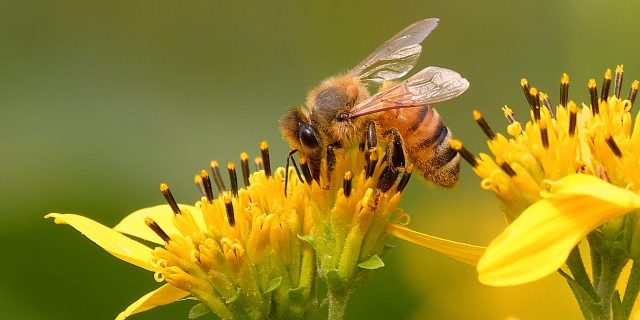21
Mar
Chemical-Driven Agriculture Damages Microbial Health of Bee Colonies

(Beyond Pesticides, March 21, 2023) Placing honey bee hives in agricultural areas creates stress that leads to microbial imbalances, according to research published in Scientific Reports by Croatian scientists this month. The research highlights the fragility and absurdity of chemical-driven agricultural systems dependent upon both pollinators and products that harm or kill off these sensitive species. While regulators in the United States continue to prop up unsustainable practices, more and more consumers are seeking out and engaging with the key alternative to this system by supporting organic farms and foodstuffs at their farmers market and grocery store.
Scientists began by creating 33 colonies from three apiaries within an agricultural region in Croatia, utilizing four brood frames, two honey frames, and mated queens. Of these 33 newly created hives, 22 were relocated to a separate agricultural region, and 11 were placed roughly six miles away from a nature preserve and considered a semi-natural area. A separate group of 10 hives that had been established on a small island (Unije, Croatia) in the Adriatic Sea were included in the study in order to represent a completely natural location.
After roughly two weeks of colony formation, scientists collected samples to represent the multiple different microbial niches within bee hives. These include bee gut, bee bread, hive entrance and internal hive air; in sum researchers term this the ‘apibiome’ of a given colony. Using a process called rRNA gene amplification, scientists conducted an analysis of the relative abundances of different bacteria detected. Focus was placed on identifying bacteria that were distinct between the three different study groups.
Hives located in primarily agricultural regions reveal a lower level of species evenness, indicating an imbalance in the abundance of species found within a hive’s apibiome. In particular, these hives had lower levels of bacteria considered beneficial for honey bees. There is also evidence of a stress response pathways within bee guts. The findings fall along a gradient, with the semi-natural hives representing a marked improvement over hives located in agricultural regions after the two-week shift. Natural hives, according to the study, “displayed bacterial profiles associated with good health, and were enriched in Acetobacteraceae and the gut core members Snodgrasella, Lactobacillus and Commensalibacter (involved in nutrient acquisition and immune responses).”
Researchers indicate that the bacterium of Arsenophonus genus were most prevalent within the agricultural hives and declined along a similar gradient from ag to natural environments. This indicates that these bacteria may be a key indicator of stressors and poor colony health brought on by difficult living conditions.
“The microbiota of the Unije Island hive is more balanced, its proportion of beneficial microorganisms is higher and in a semi-natural environment the proportion gradually decreases, whereas in the agricultural environment the composition of the hive is highly imbalanced, more opportunistic bacteria are found and it is more sensitive to diseases,” explained Iratxe Zarraonaindia, PhD.
These data match up closely with prior research on the damage that agricultural pesticide use can do to individual honeybee microbiomes. A study published in 2016 found that mixtures of various pesticides results in adverse changes to the make-up of honeybee gut bacteria. Another study on pesticide mixtures published six years later found that such adverse changes to a honeybee’s gut increases susceptibility to disease and pathogens, and likely reduces a pollinator’s life span. A meta-analysis conducted in early 2022 determined that pesticides create these disturbances in one of two ways – either by directly harming microbes or by indirectly harming pollinators, resulting in gut microbial shifts.
Researchers continue to find new ways in which chemical-intensive agriculture is harming pollinators and the wider environment, underscoring the need for alternative systems that do not utilize these dangerous practices. It is imperative for those concerned about pollinator protection to engage with and help grow these alternatives.
Beyond Pesticides has long embraced organic agriculture as the key response to the damages brought about by pesticide-laden food production. But even organic can be subject to weakening and corporate attack, necessitating an engaged consumer base. Join Beyond Pesticides today in urging Organic to Lead the Way by contributing your voice to strong organic agriculture at upcoming the National Organic Standards Board meeting.
All unattributed positions and opinions in this piece are those of Beyond Pesticides.
Source: Scientific Reports, Phys.org press release










